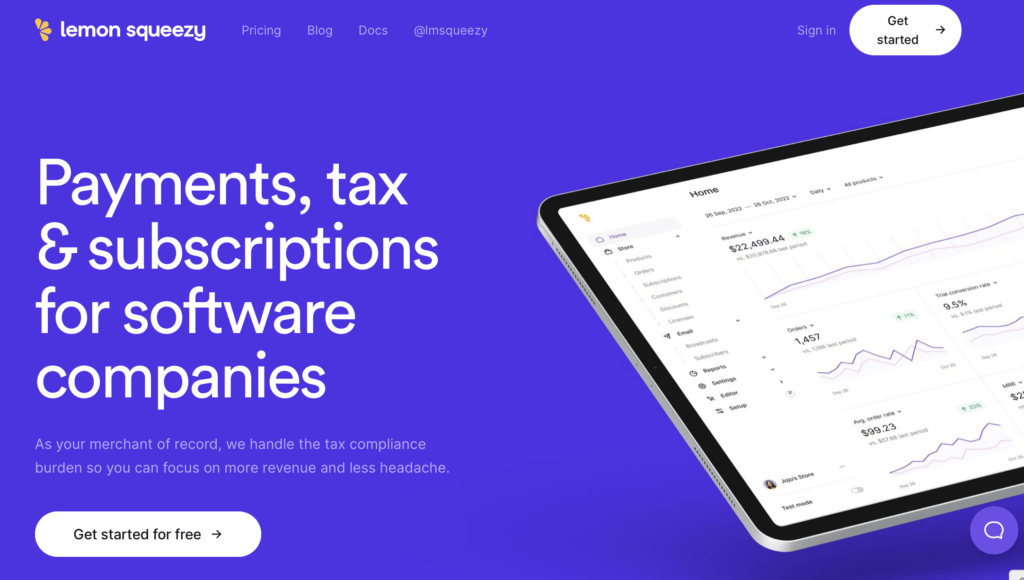Are you looking for ways to monetize your audience and sell your goods online? Maybe you have an amazing online course, a service you can offer, handmade furniture, a digital book, or some music you’ve been eager to sell, but aren’t sure how?
You’re in luck – selling products online is easier than ever and we can help you get started!
Selling digital or physical goods

Your online sales strategy has to be adapted to what kind of product you are selling.
If your goods are tangible, such as clothes, records or furniture, you will need to think about shipping, while digital goods such as e-books or online courses can be delivered in one click.
Digital goods can be particularly interesting for several reasons:
- No inventory: With digital products, you don’t have to worry about storing and shipping, which can save you time and money.
- Easy to distribute: Digital products can be delivered to customers in one click, making it easier to reach a global market.
- High profit margin: Since they don’t incur any production or shipping costs, digital products often have a high profit margin.
These differences between physical and digital goods will influence what platform you will use to sell your products, but don’t worry – these days, anything is possible!
Before you can start selling, you’ll need to have everything in place.
Let’s take a look at some of the platforms and tools available for selling digital goods online.
E-commerce platforms
An e-commerce platform is a software solution that allows you to sell products and services online. It provides one location where you can manage your digital assets, sales, and marketing efforts. These platforms usually include features such as a shopping cart, payment processing, and inventory management.
E-commerce platforms can be:
- B2B (business to business)
- B2C (business to consumer)
- C2C (consumer to consumer)
- C2B (consumer to business)
You’re probably B2C — or C2C if you consider yourself super-indie!
The three main types of e-commerce platforms are SaaS (software-as-a-service), PaaS (platform-as-a-service), and on-premises platforms. You need to consider their different characteristics in order to choose the one that will work best for you!
SaaS e-commerce platforms are cloud-based platforms that allow businesses to build and run online stores. They offer a range of tools and features for managing and selling products, such as customizable product pages, payment processing, and marketing tools.
These platforms are fully-managed solutions, meaning that they handle all the technical aspects of running an online store, such as hosting, security, and maintenance. You don’t need to worry about the behind-the-scenes and can focus on making sales!
Examples of SaaS e-commerce platforms include Shopify, BigCommerce, Gumroad and SendOwl.
PaaS platforms, on the other hand, offer a range of tools and services that developers can use to create custom e-commerce solutions. They typically provide a flexible and scalable development platform, with features such as APIs (Application Programming Interfaces), integrations, and customization options.
PaaS platforms are often used by businesses that want to build a highly customized and sophisticated online store, and that have the technical expertise and resources to manage their own e-commerce infrastructure.
Examples of PaaS e-commerce platforms include Salesforce Commerce Cloud, Magento Commerce, BigCommerce Enterprise, Oracle Cloud Platform, IBM Cloud Platform, and Microsoft Azure.
Finally, on-premises platforms are installed and run on a merchant’s own servers, rather than being hosted in the cloud. This allows merchants to have full control over their e-commerce infrastructure, but it also means they are responsible for maintaining and updating the platform themselves. On-premises platforms are generally more expensive and require more technical expertise to set up and manage than SaaS or PaaS platforms.
Top Platforms for selling digital products globally
We will get into the details of other ways to buy technology to take on a portion of your selling infrastructure.
But the reality is, the best place to start for many creators who want to focus on sales and marketing is to get an all-in-one solution that handles
Lemon Squeezy
Lemon Squeezy recently dropped their pricing from a tiered system to a 5% fee. They started as a competitor to Gumroad but are moving to offer more SaaS solutions. They act as a Merchant of Record, allowing you to not have to worry about accepting multiple payments or remitting sales tax.
Paddle
Paddle is a similar venture-backed service that has an extreme focus on being an all-in-one SaaS solution for large SaaS companies.
Paddle is less focused on indie creators but may offer solutions for you if you are building enterprise subscription products.
Gumroad
Gumroad is one of the original pioneers in this field, having emerged in the category of ‘indie digital marketplace and storefront’. They recently hiked their fees up to 10%, which suggests a change in their business model to be more of a premium retail marketplace like Patreon, Amazon or the App Store.
WordPress Plugins
Hey, maybe you really do just want something really light and simple.
There are chances you’ve created your website using WordPress.
Good news: you could sell your digital goods from there too!
And if you are on some other platform, like Ghost, chances are you can look into custom themes and integrations with payment plugins as well.
For memberships and newsletters, Ghost has payment functionality built right in.
WordPress plugins (and other plugins) are software extensions that can be added to a WordPress website to add new features and functionality, and many WordPress plugins can be used to enhance an e-commerce website, including plugins for payment processing, shipping and fulfillment, marketing, customer service, and more.
Some examples of WordPress plugins are WooCommerce, HubSpot and WPForms.
There are several benefits to using WordPress plugins for e-commerce:
- Enhanced functionality: WordPress plugins can add a wide range of new features and functionality to an e-commerce website, making it even more effective.
- Customization: WordPress plugins allow businesses to tailor their e-commerce website to their specific needs and goals. There are many plugins available, so businesses can choose the ones that best meet their needs and which may help them stand out.
- Ease of use: WordPress plugins are easy to install and manage, and many offer intuitive user interfaces and guides to help users get started.
- Cost-effectiveness: Many WordPress plugins are available for free or at a low cost, making them a cost-effective option for businesses looking to add new features and functionality to their e-commerce website.
- Scalability: WordPress plugins are designed to be scalable, so businesses can add or remove them as needed to meet changing business needs.
How do you choose your e-commerce platform?
There are several factors that a company should consider when choosing an e-commerce platform:
- Business needs: First, you must identify the specific needs and goals of your business. What kind of products are you selling? What’s your target market? What volume of sales do you expect? How customized and scalable do you need your e-commerce platform to be?
- Platform features: Next, compare the features and tools offered by different e-commerce platforms. Which ones are most relevant to your business’s needs? Consider features such as payment processing, shipping and fulfillment, marketing or customer service.
- Cost: You must of course consider your means. Look at upfront fees, monthly or annual subscription fees, and transaction fees. It’s also crucial to think about the long-term cost of using a platform, as some platforms may have higher costs for scaling or adding new features.
- Ease of use: If you don’t have a lot of technical expertise, you really need to think about the ease of use of your e-commerce platform. Platforms with a more intuitive user interface and good guides can be easier to navigate.
- Integration: It’s important to consider how well an e-commerce platform integrates with other systems and tools that your business uses, such as payment gateways, CRM software, CMS, ERP system and marketing tools.
As mentioned above, the type of good you are selling online is important to think about.
E-commerce platforms that are specifically designed for digital goods generally offer features such as customizable sales pages, file hosting and delivery, and marketing tools to help creators promote and sell their products online. By contrast, e-commerce platforms that specifically designed for physical goods typically also offer shipping integrations to help merchants manage and grow their online businesses. So make sure you don’t sign up for a platform that offers functionalities you won’t need!
Payment processors
Once you’ve chosen and set up your platform, you need a payment processor.
Payments processors are online services that allow you to accept payments from customers for your goods. Some popular options include PayPal and Stripe.
Stripe and PayPal provide credit card processing services, and while both offer similar services, they have some differences in their focus and capabilities.
Stripe is primarily a merchant services provider, meaning it offers a variety of payment options and allows you to customize it for online or in-person sales. This makes it a good choice for businesses that engage in high volume sales and want the ability to accept many forms of payment.
PayPal, on the other hand, is mainly a digital wallet, allowing customers to make payments and send money online. It’s a good option for businesses that already use the platform for invoicing and receiving payments, or for businesses that primarily operate online.
In deciding which payment processor is right for your business, think about your specific needs and choose the option that best fits them. Both Stripe and PayPal offer a range of features and benefits, but it’s up to you to make the call!
Tips to help you sell your product online
- Include the shop button on the homepage: Make it easy for your visitors to find your online shop quickly!
- Offer incentives to visit the online shop: Think of creative and innovative ways to drive traffic to your website, and then, encourage visitors to go to the online store.
- Make the website mobile-optimized: Nowadays, many of us do most of our browsing and shopping from our smartphones. Make sure that your website and online shop come in a mobile-friendly version to improve the customer experience and help with Google ranking.
- Highlight your unique selling point: Any good business has strong core values and a unique offer – and these can be used to help your online store stand out. Mention these values within your online shop to create a deeper message for your customers.
- Use calls to action: Calls to action on your website or as part of your social media marketing campaign can help increase your conversion rate. Power words combined with a strong benefit for your customer can persuade website visitors to make the jump to purchase. For instance, offer free shipping when a certain amount is spent, discounts for signing up to your mailing list, and limited-time sales or offers.
- Curate the user journey: Websites today simply need to be enjoyable to look at and navigate. The design of your online store should guide visitors around the store and encourage them to make a purchase. This can include pushing best-sellers to the top of the page, bundling products, and creating categories to help customers filter what they are interested in buying.
- Use high-quality images: Since your customers can’t see your products for themselves, you need to give them good-quality images of it to convince them to click “add to cart.”
- Write good product copy: Keep product descriptions concise and relevant, and try to use a tone that fits your brand and isn’t robotic.
- Include customer reviews: We all read reviews before buying a product online! Plus, sharing your customers’ feedback on your online store shows your confidence in your own product. If your previous customers had a good experience with the shop and were satisfied with the product they purchased, their words just may attract a new buyer.
How to advertise your product online
Now that your online store is all set, you need to spread the word about your product. Advertising your product online can be an effective way to reach a wider audience and drive sales. Here are six key steps to follow when doing so:
- Identify (or remember) your target audience: Who are you trying to reach with your product? Understanding your target audience and what their taste and needs are will help you determine the best platforms and tactics to use to reach them.
- Determine the best platforms to reach your audience: There are many platforms you can use to advertise your product online, including social media, search engines, and online marketplaces. Think about where your target audience is most likely to be found and which platforms will give you the best visibility.
- Create promotional material: Once you know where you want to advertise, start creating ads and other promotional material to showcase your product. This can include social media posts, banners, videos, or sponsored content. Make sure to highlight the benefits of your product and why it’s better than the competition!
- Track your performance: Use analytics tools to track the performance of your ads and other efforts. This will help you see what’s working well and what isn’t so you can adjust your strategy as needed.
- Offer promotions: People love a good deal! Consider offering discounts or promotions to encourage purchases, such as a limited-time offer or a special deal for first-time buyers.
- Engage with potential customers: Regularly update your online presence and engage with potential customers to build a strong brand and appear as a real human being, rather than just a store window. For instance, respond to comments and messages, share updates about your product, and interact with users on social media.
Conclusion
Selling digital goods online has never been so easy! With all the different e-commerce options available, you are bound to find the one that will suit your needs and help you turn in a profit. Make sure to also use all the tools out there to spread the word about your product! Social media is a great avenue for promoting what you have to offer, and with our Ultimate Guides to Twitter, Instagram, Facebook and LinkedIn Marketing, you’re sure to reach your goals!










